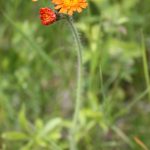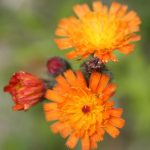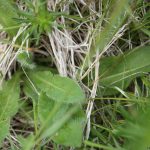Orange hawkweed
Prepared by Jennifer L. D’Appollonio, Assistant Scientist, University of Maine, Orono, ME 04469. March 2011.
Scientific name: Hieracium aurantiacum L.
Common name(s): orange hawkweed, tawny hawkweed
Link(s): USDA PLANTS Profile, Go Botany
Images: (to see enlargements [PC]: click on image, then right click and choose “view image”)
- in flower, early June
- flower detail
- leaf detail
Description:
-perennial
-leaves are basal covered in trichomes
-10-36 inches tall
-spreads through stolons
-roots are shallow and fibrous
-generally flowers May to July in ME
-generally fruits July, August in ME
Habitat:
-grasslands
-forests
-wetlands
Agriculture:
-visited by a variety of insects, including bees and butterflies
-leaves are nutritious but trichomes limit herbivory
Management:
-maintain the integrity of the native plant community is more effective than managing solely to control
- avoid building roads where you don’t want this weed
– Physical disturbance by machinery may spread orange hawkweed across fields
-disturbances such as activity by livestock and wildlife may enhance its spread
– Hand removal from lawns is more effective if used in conjunction with fertilizer
-Herbicides are effective in gaining initial control but they are rarely a r long-term solution to management
Source(s):
Hansen, R.W., S.B. Hansen and E.A. Osgood. 1991. Reproductive phenologies of selected flowering plants in eastern Maine forests. ME Agric. Exp. Station Tech. Bull. 143. 17 pp.
Heinrich, B. 1976. Flowering phenologies: Bog, woodland, and disturbed habitats. Ecology. 57(5):890-899.
U.S. Forest Service. “Hieracium Aurantiacum.” Fire Effects Information System (FEIS), USDA, 2020, www.fs.fed.us/database/feis/plants/forb/hieaur/all.html.



